Introduction, Specifications, and Pricing
Historically, November is the month when SSDs prices fall before holding steady into the New Year. Over the last two years, the price declines were minimal due to datacenter demand and the slow transition to 3D memory lowering supply. We are back to a consumer-friendly flash market with ample supply and expect to see additional pricing reductions in the coming days as the shopping season heats up.
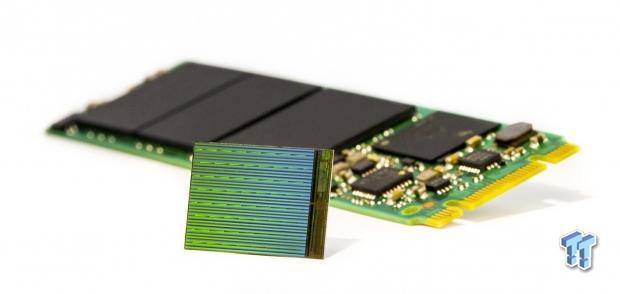
Personally, I'm difficult to shop for. What do you buy someone that usually just buys what they want regardless of the season? That's just part of living the digital lifestyle. Your family and friends can't really shop for you because they don't even know the products you want even exist. On the other side of the coin, there are people in your life that are equally difficult to shop for.
My pick of products for those difficult to shop for is a large capacity SSD. SSD prices have declined, and nearly every techy can benefit from an injection of high capacity, speedy space. Today we will look at a few options that I personally like (and would love to get myself).
Specifications
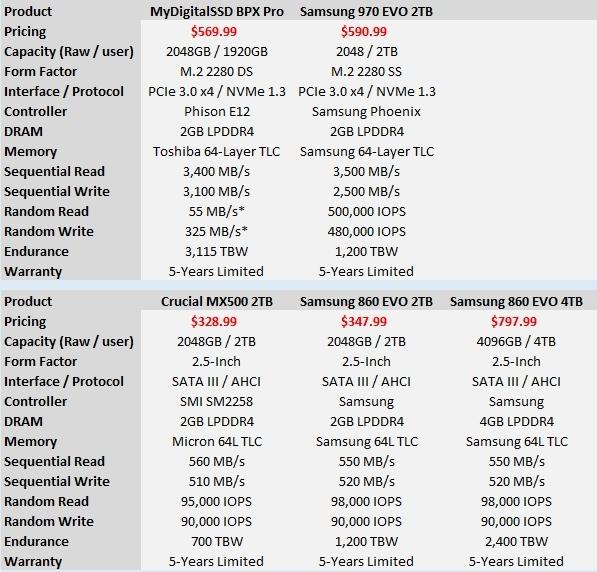
I'm not picky when it comes to high capacity drives. I personally like to use these as secondary storage for organization reasons. There is also a performance benefit to keeping most of your cold data on a second drive rather than you same one you use to run applications.
My list includes two M.2 NVMe SSDs that deliver both high capacity and exceptional performance. I also chose two 2TB SATA SSDs and one 4TB model that lets you be a little naughty with any leftover holiday money that you might want to spend on yourself.
MyDigitalSSD BPX Pro 1920GB
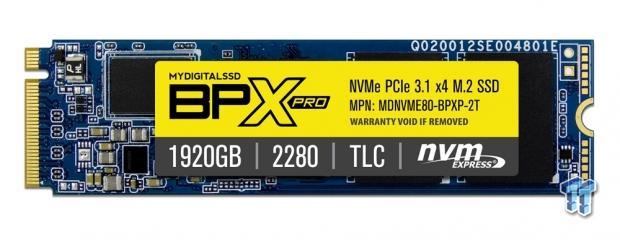
We will lead off with the latest NVMe drive to come to market, the MyDigitalSSD BPX Pro. The 240GB to 960GB models shipped early in the release cycle for this series but the new 1920GB drive is now available. We found the drive at Amazon for $519.99 with a 5-year warranty. The drive uses the latest Phison PS5012-E12 controller built on the 28nm node so it runs much cooler than the previous generation.
Samsung 970 EVO 2TB
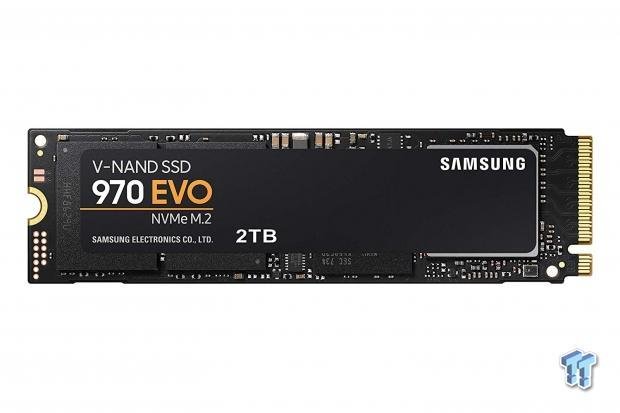
Samsung didn't release a 2TB 970 Pro, but consumers do have the opportunity to dance with the 970 EVO in a massive 2TB capacity. The drive delivers on Samsung's key features that have led the company to become many shoppers most trusted SSD supplier. The 970 EVO uses Samsung's latest "Phoenix" NVMe controller, the same used in the company's expensive datacenter products including the Z-Drive. We found the drive on Amazon for $591.37, and Samsung backs this series with a 5-year warranty.
Crucial MX500 2TB
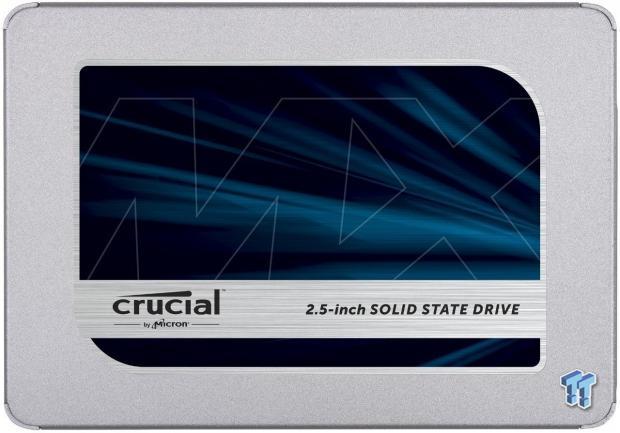
The lowest pricing on our list for a high capacity model comes from Crucial's MX500 2TB. The drive is on Amazon now for just $328.99 but don't be caught up in pricing just yet. The MX500 delivers exceptional random read performance, so it performs exceptionally well in application performance.
Samsung 860 EVO 2TB
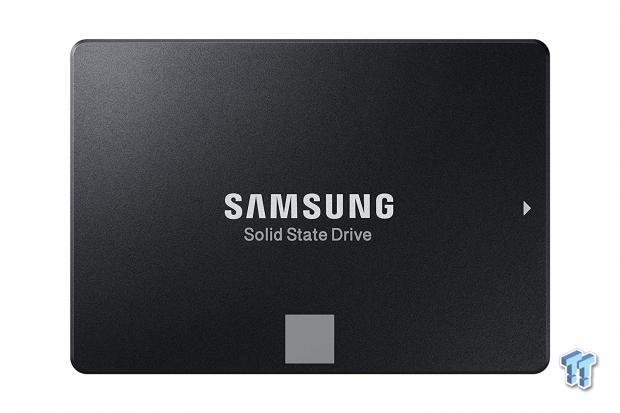
The Samsung 860 EVO 2TB is not always as fast as the Crucial MX500 2TB, but it makes up for slightly less performance by giving users more endurance. The latest SATA EVO series gives us so much endurance that most users will be able to use these drives for ten years before hitting half of the claimed data writes possible. The 2TB 860 EVO moves the price up to $347.99 at the time of writing and is in stock at Amazon.
Samsung 860 EVO 4TB
I don't think I could give Samsung's 4TB 860 EVO away. If I bought one to give away, it would need to ship straight to the recipient because once I got my hands-on it, I'm not letting it go! The 4TB EVO sells for $769.99 on Amazon and is one of the few consumer-grade models in this capacity. Samsung did release a 4TB 860 Pro SSD but it's current $1,191.55 price is a bit more than what most shoppers spend during the holiday season. That doesn't mean you can't ask for the 4TB 860 Pro for your birthday though.
Initial Performance Testing
Testing Notes
This is the perfect opportunity to detail my SSD testing systems. At the heart of each system is an Asrock Z270 Taichi motherboard fitted with an Intel 7700K running with each core locked at 4.5GHz. Each system uses two Crucial Ballistix DDR4 memory modules that offer exceptional compatibility with all of my test systems regardless of the chipset.
If you take our advice and run your new high capacity SSD as a secondary volume for cold file storage the data likely changes. Secondary files are usually based on large block sizes and sequential in nature. This includes your pictures, music, and movies. It is possible to load your games and other applications to secondary storage.
You simply install the software to drive D: or whatever the new drive letter is. I go as far as making the Program Files folder (D:Program Files (x86) and D:Program Files) to make it a little easier to keep the data organized. It's very easy to let the data on a 2TB drive to get out of control. Organization and a little planning is the key to success here, or else you will just start throwing data on the drive, and it can take hours to get it all sorted back out. Don't even ask me about the condition of my NAS right now.
We combined our five top picks for high capacity SSD storage in the same charts. It's rare to see legacy SATA in the same charts with NVMe, and you will see why soon. There are no losers here today in this article. Every drive we chose has an advantage somewhere, be it random performance, large block-size write performance, an exceptional value or enough endurance to last a lifetime.
Sequential Read Performance
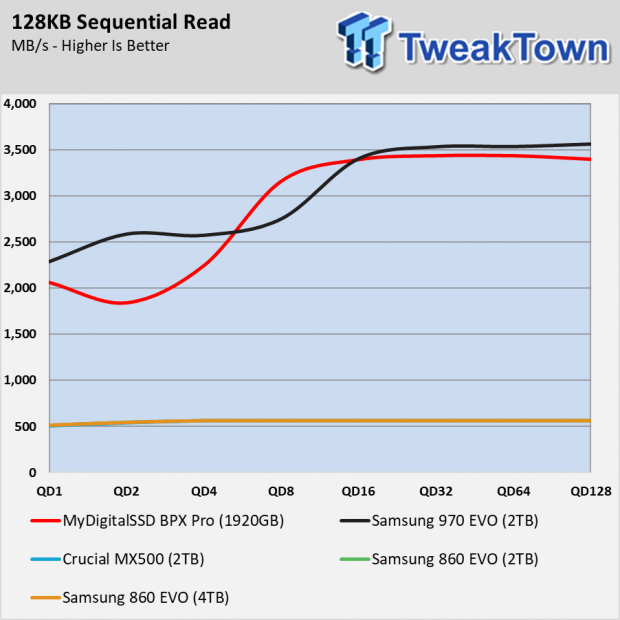
We need to preface the sequential read test results with a disclaimer. The MyDigitalSSD BPX Pro and all E12-based drives we've tested have an issue with our script that shows reduced sequential reads at queue depth 2 and 4. We think the issue is just a simple case of timing, when these two tests come in our script, the amount of delay between the tests, or in simple terms, bad luck. Phison is looking into the issue.
The two NVMe SSDs deliver towering sequential read performance compared to the three SATA SSDs. They also cost significantly more but as a secondary volume for large block size data, it's impossible to beat a proper 2TB NVMe SSD.
Sequential Write Performance
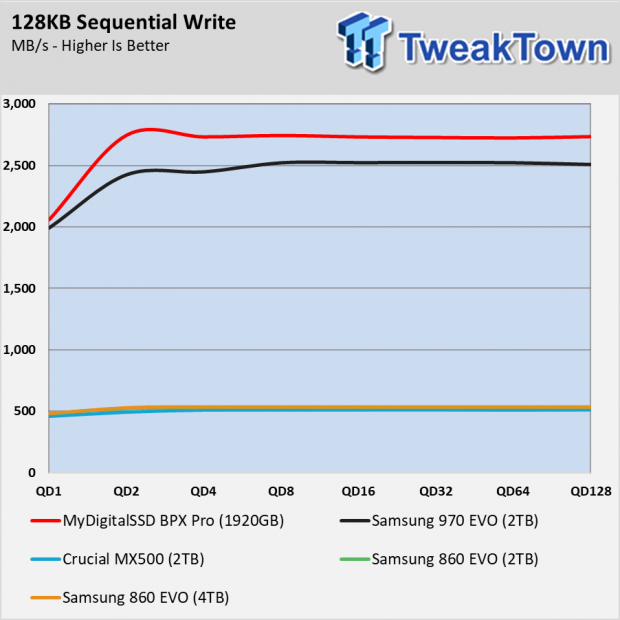
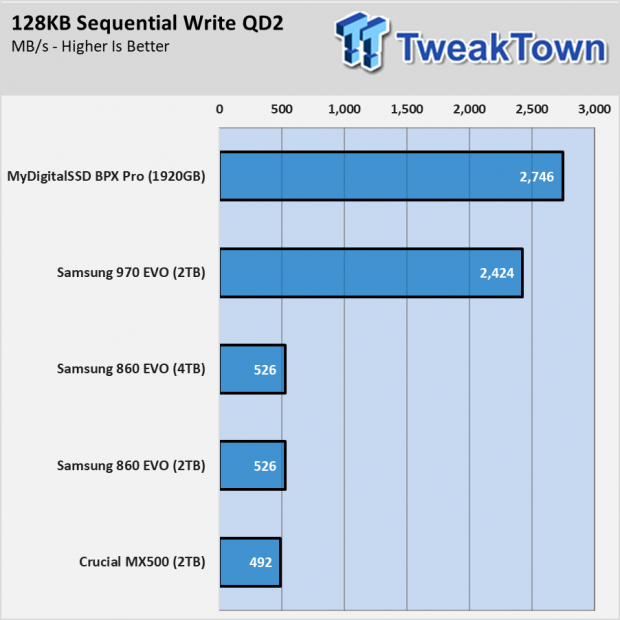
Again, we see the NVMe SSDs outperform the SATA SSDs. Actually using the increased performance is another issue entirely. Since this is sequential data it likely comes from another drive or from across the network. If the data comes from a SATA SSD in the same system then you will likely see data writes between 300 and 500 MB/s even with a NVMe SSD as the target drive. Over a network, you will need a 10-gigabit connection just to write roughly 1000 MB/s to the NVMe SSD, and that's assuming your NAS or other device sending the data can sustain bursts that high. To fully utilize the NVMe SSDs you need another NVMe SSD as the source of the data transfer.
Sustained Sequential Write Performance
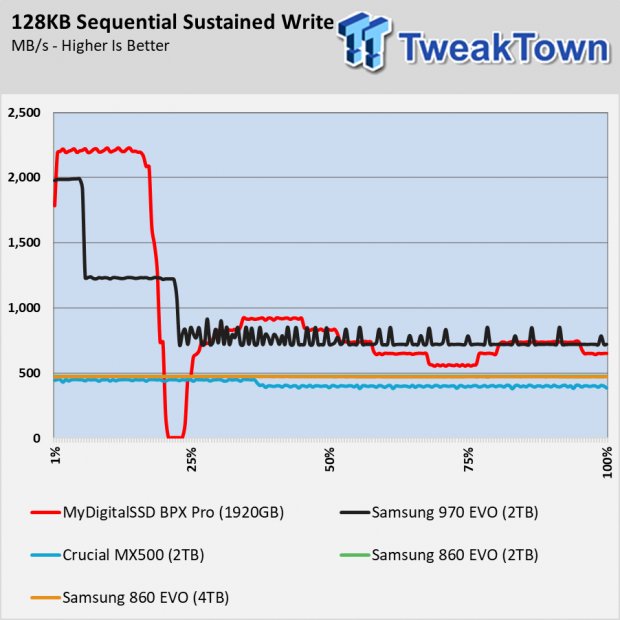
We have three-bit per cell flash media to thank for low-cost large-capacity SSDs available today. This media does have a drawback compared to older two-bit per cell (TLC) media when it comes to sustained writes. The drives use a buffer to write at high speeds but in many cases, the buffer ends, and the data transfer rate slows. Some drives continue to pass the data through the buffer, but that data has to slow so it can flush to the TLC area. Other drives will hold the data in the buffer and then start to write directly to the TLC area. Regardless of the method, there is usually a limited space for maximum performance sequential data writes to the drives.
Random Read Performance
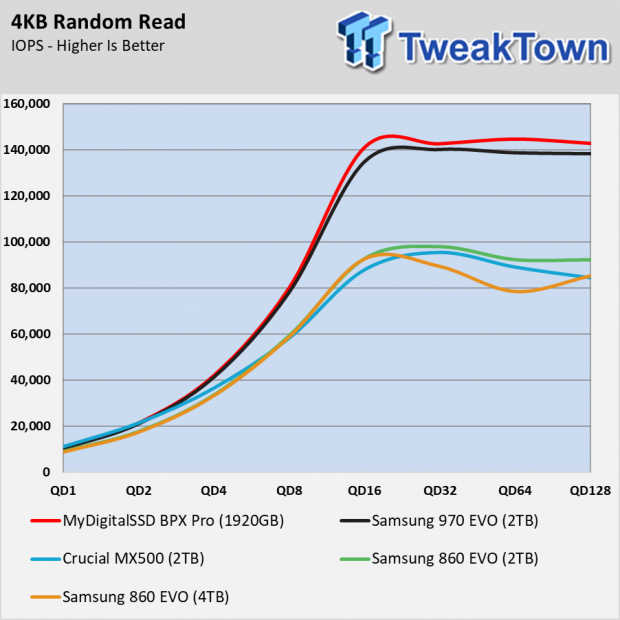
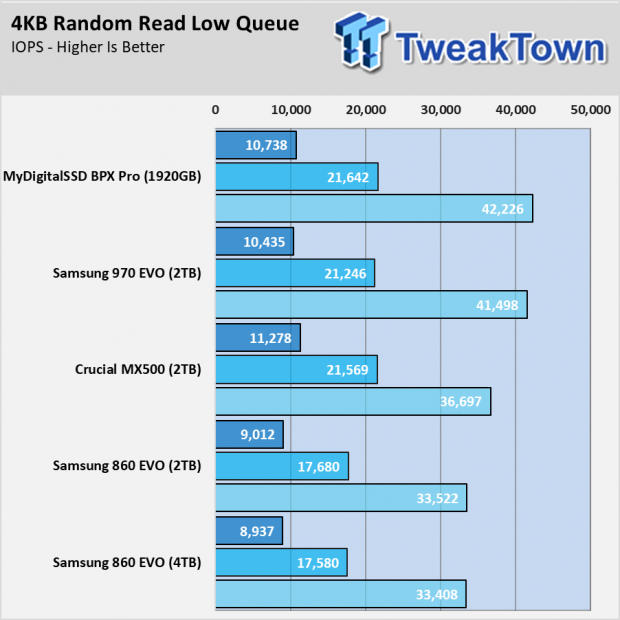
If you plan to use your new high-capacity SSD for primary storage with your operating system and cold storage files on the same drive, then the random read performance charts are more important than the sequential results.
You will quickly notice the fastest drive at queue depth 1 random reads is actually the cheapest SSD on the charts today. The Crucial MX500 uses Micron 64-layer memory that is exceptionally quick. We often hear from readers that NVMe SSDs don't feel any faster than newer SATA SSDs. The random read performance is why. This is the area that you notice the latency between clicking an icon and seeing the requested action start or complete. We will look at this more on the next page where we start ripping through applications.
Random Write Performance
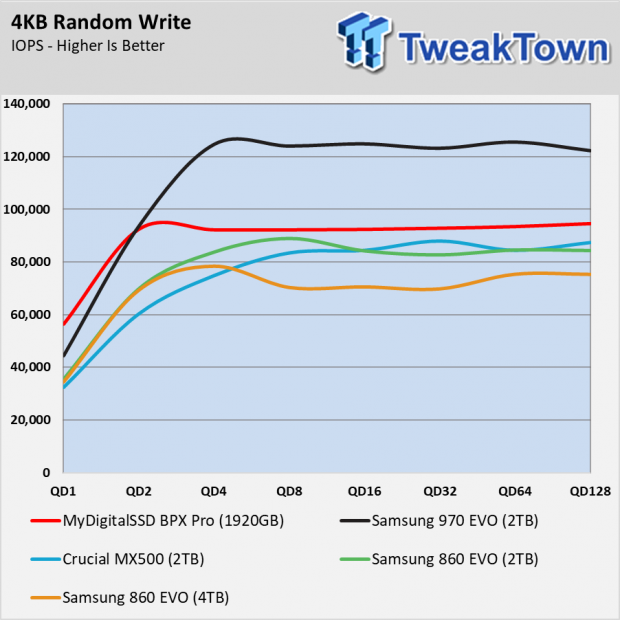
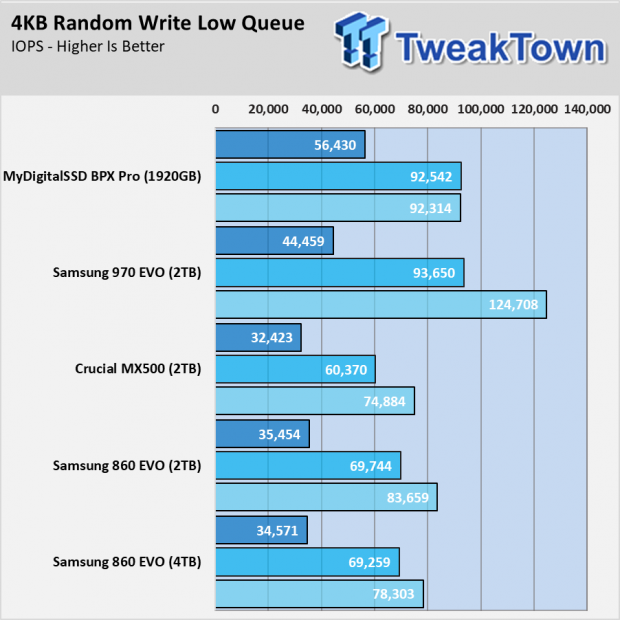
Random write performance is still importable but the SLC buffer speeds make these actions complete so quickly that we've reached a point where the other components in the system, and the underlying operating system / file system, don't allow normal applications to take advantage of the increased performance.
70% Read Sequential Performance
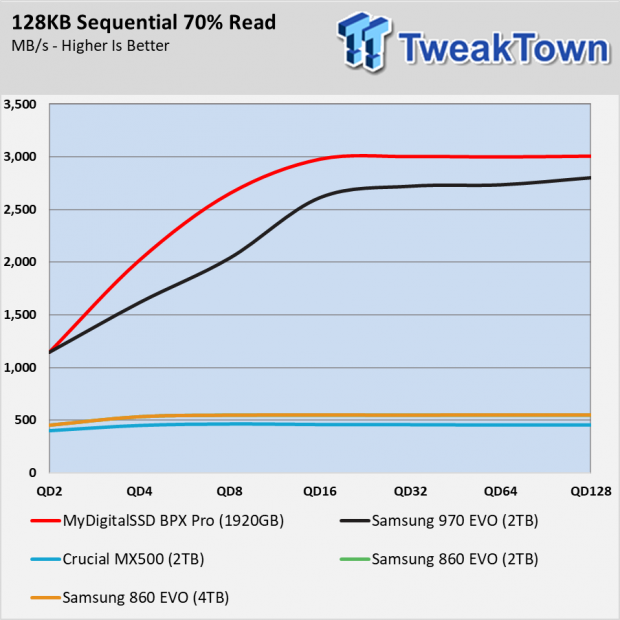
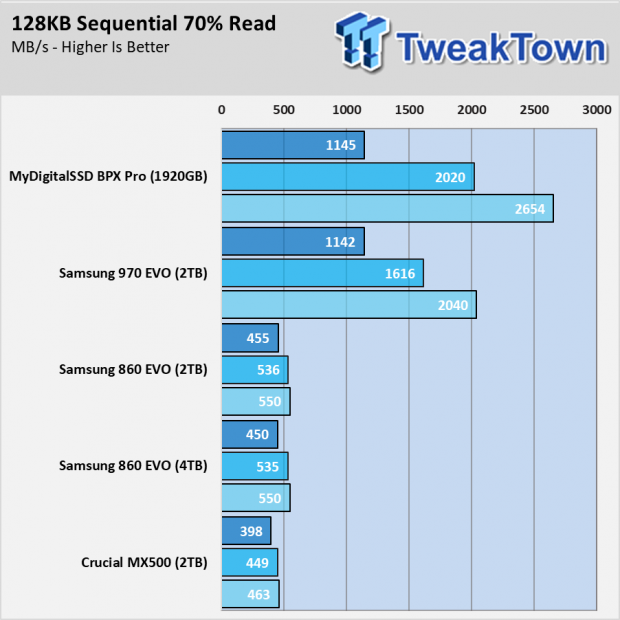
NVMe has a great feature that we often overlook in our reviews. The PCIe bus and NVMe protocol allow the SSD to read and write data at the same time. The SATA bus doesn't allow the other drives to do this. The advantage comes when multitasking with several programs running at the same time.
70% Read Random Performance
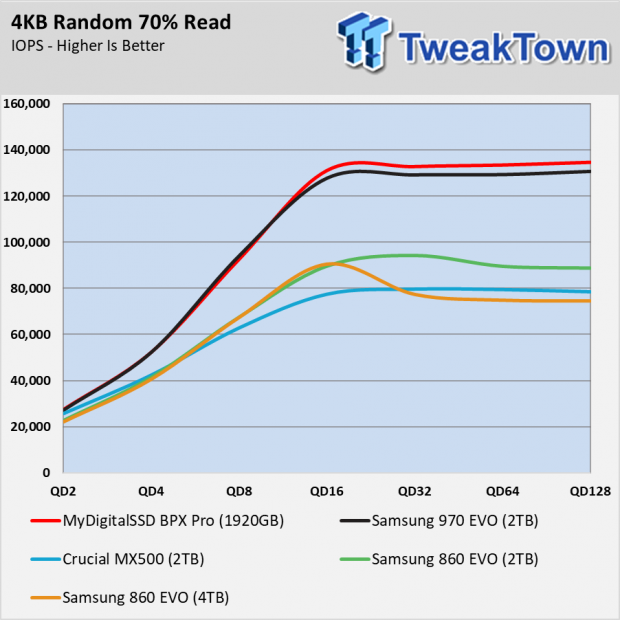
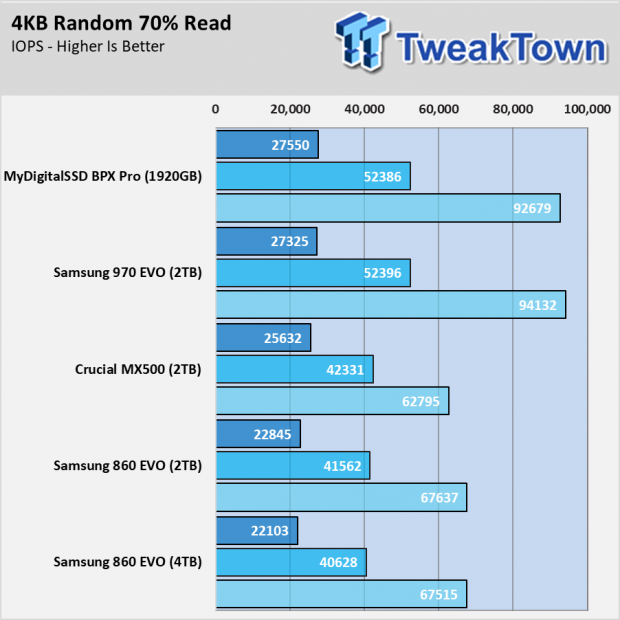
The real difference comes with random data reading and writing at the same time. NVMe SSDs are faster but you have to put a little work into your system to benefit from the technology. Operating system buffers do a good job of masking SATA's limited abilities to the point where the two technologies are very similar in daily use activities.
Class Real-World Performance Testing
Game Load Time
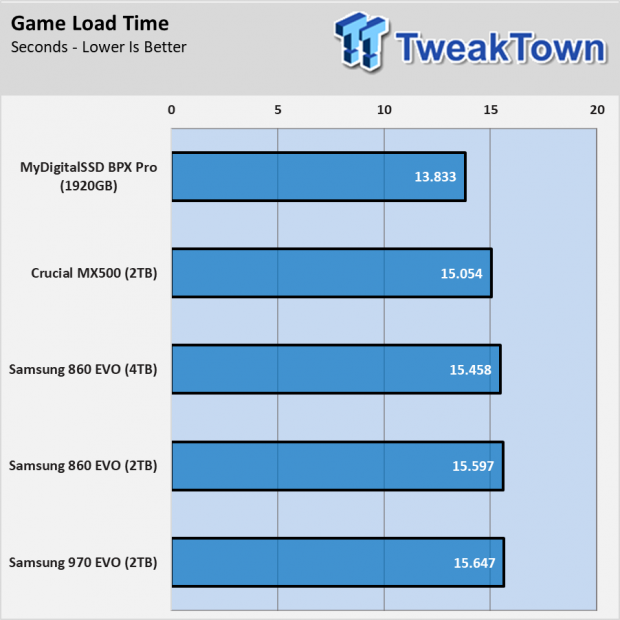
On this page, we will rank the high-capacity SSDs in the charts based on performance. Our game load time test comes from Final Fantasy: Stormblood.
The MyDigitalSSD BPX Pro with new 64-layer Toshiba BiCS FLASH outperforms the other products in this test. It's an exceptional drive for light applications. The Crucial MX500 follows the BPX Pro with it's 64-layer Micron flash that we've been impressed with all year. The three trailing Samsung SSDs follow close behind and shouldn't be overlooked.
PCMark 8 Total Storage Bandwidth
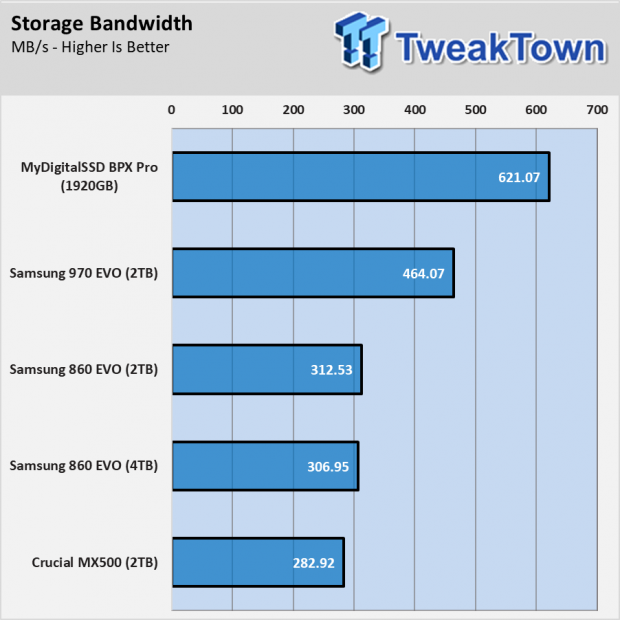
The PCMark 8 Total Storage Bandwidth test uses nine applications to run ten tests using applications we all use every day, like Word, Excel, Photoshop and so on. The BPX Pro comes out on top here and the 970 EVO, the other drive running the NVMe protocol, follows.
PCMark 8 Extended Storage Test
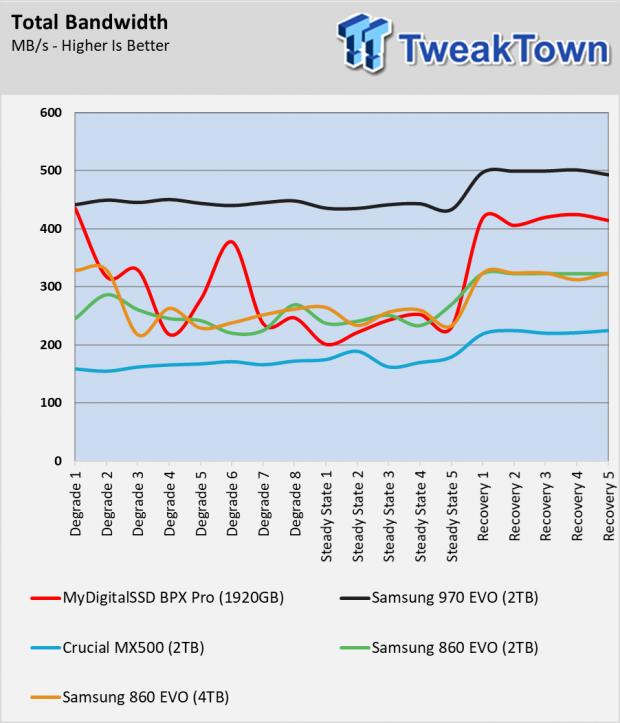
The Extended Storage Test shows what happens when you push past the drive's buffer with a heavy workload. This includes writing data to the drives rapidly. Here the Samsung 970 EVO runs over the other drives but not just in performance alone. The 970 EVO, like the Crucial MX500, shows consistent performance across each pass. The other drives ebb and flow as the buffers and controllers struggle to manage the data.
SYSmark 2014 SE System Responsiveness and Power Tests
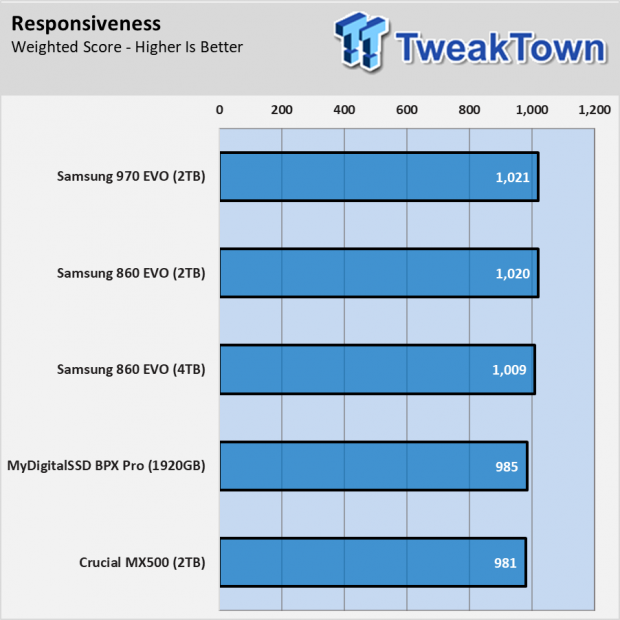
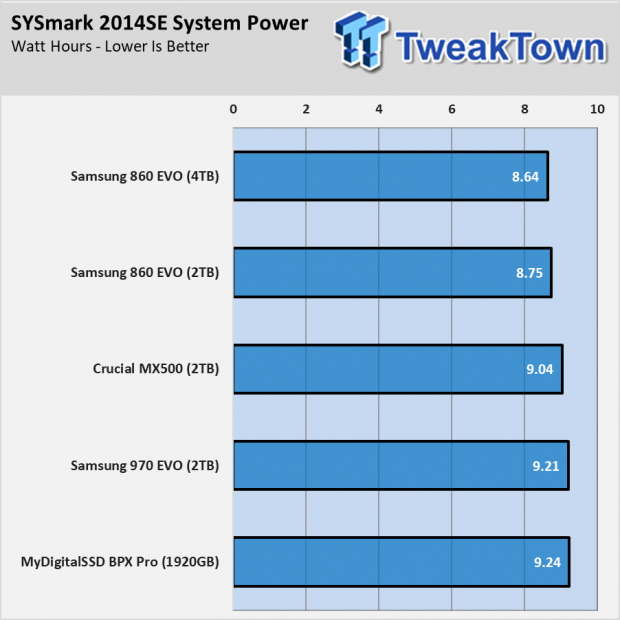
SYSmark 2014 SE runs applications from Microsoft, Adobe, WinZip and others to measure overall system performance as well as disk performance from the Responsiveness Test. The test runs the software over a time to mimic the first half of an office workers day. The software runs a detailed script that it even accounts for trips to the coffee maker.
The software is system dependent to keep the scores consistent so we use one of our 4 Lenovo Y700-17 gaming notebooks with a Core i7-6800 processor and 16GB of system memory. The score uses system latency but a higher score means a better user experience.
The Samsung 970 EVO 2TB leads the two Samsung SATA SSDs in responsiveness. The test runs over several hours but isn't stressful beyond what you may experience in your typical day at the office.
Notebook Battery Life
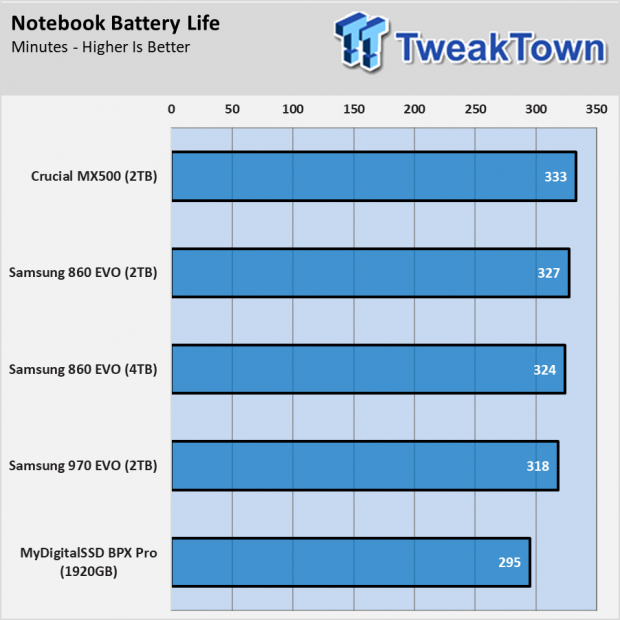
Our final test runs on the same Lenovo Y700-17 gaming notebooks. We run MobileMark 2012 Version 1.5 to measure notebook battery life. BAPCo designed the software to compare different notebooks but we repurposed it to use the same notebook, just with different configurations such as system memory or in this case, storage products.
The Crucial MX500 2TB delivered the longest battery life in our gaming system. It scored 333 minutes. The 2TB 860 EVO trailed by six minutes and the 4TB EVO trailed by 9 minutes.
Final Thoughts
As we mentioned earlier in the article, there are no losers when it comes to the products we tested today. Each drive has a leg up on the others in some area. It could be price, short or long-term performance, exceptional performance in a notebook or something as simple as a price advantage.

We also have a holiday theme going in this article but you don't need to wait on someone else to pull the trigger before stuffing one of these great drives in your system. An SSD might not be on your secret shopper's list either, but I don't know anyone that doesn't want a faster PC experience. The increased capacity also let's people use their computer again like it sport a hard disk drive, less moving or deleting data like you do with a smaller SSD.
We've heard the promise of high capacity SSDs coming for several years now. Intel's former CEO famously said on stage that 3D flash would enable "4TB in the size of a stick of gum." It's been a few years and people are eager to not only see these products but to experience them as well.
Over the next twelve to eighteen months, market conditions should allow companies to ship realistic 4TB products. In January, we should start to see the latest 96-layer memory from most of the fabs and customer SSD manufacturers. We've already tested an early reference design sample with 2TB of 96-layer memory. 2TB will be the standard like 1TB is now for enthusiasts in just a few months. That doesn't mean you need to wait for more options to emerge. As we saw today, there are really strong options available today and prices are affordable. We expect to see some movement on pricing towards the end of November so be on the lookout for great deals as we get closer.

 United
States: Find other tech and computer products like this
over at
United
States: Find other tech and computer products like this
over at  United
Kingdom: Find other tech and computer products like this
over at
United
Kingdom: Find other tech and computer products like this
over at  Australia:
Find other tech and computer products like this over at
Australia:
Find other tech and computer products like this over at  Canada:
Find other tech and computer products like this over at
Canada:
Find other tech and computer products like this over at  Deutschland:
Finde andere Technik- und Computerprodukte wie dieses auf
Deutschland:
Finde andere Technik- und Computerprodukte wie dieses auf